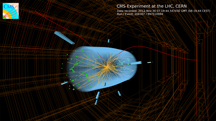Purdue physicists part of discovery of rare particle decay predicted by the Standard Model
August 19, 2013
 |
|
Red lines show the disintegration of a B-sub-s into two muons in the CMS camera at the Large Hadron Collider. Yello, green and blue are used to denote particles other than muons. Purdue University physicists were part of the discovery of the B-sub-s decay process that is consistent with the Standard Model of particle physics. (Image courtesy of Ian Shipsey/CERN) |
WEST LAFAYETTE, Ind. — Purdue University researchers are part of a team that made a discovery that offers more evidence to support the Standard Model of physics.
Researchers from the Compact Muon Solenoid (CMS) and Large Hadron Collider beauty collaborations (LHCb) in July announced findings of a rare particle decay that agrees closely with the Standard Model of particle physics. The collaborations involved experiments using the Large Hadron Collider (LHC) at CERN, the European Organization for Nuclear Research laboratory in Geneva, Switzerland.
The collaborations found strong evidence that a particle called B-sub-s disintegrates into pairs of muons at a rate consistent with the Standard Model's prediction of one in every 280 million.
Purdue's particle physics group has been a part of the historical international experiments at CERN and the hunt for the Higgs boson for more than two decades. In July of 2012, a team of scientists representing the international collaboration announced the discovery of the Higgs particle.
The Purdue particle physics group includes physics professors Virgil Barnes, Daniela Bortoletto, Laszlo Gutay, Matthew Jones, David Miller, Norbert Neumeister, Ian Shipsey, Fuqiang Wang and Wei Xie, and professor emeritus Arthur Garfinkel.
Shipsey, the Julian Schwinger Distinguished Professor of Physics, is chair of the CMS Collaboration Board. He and his postdoctoral researchers and graduate students were part of the discovery team. The group included graduate students Zhen Hu and Jian Sun and postdoctoral researchers Nuno Leonardo and Marco de Mattia.
"This was the culmination of a search that was first attempted in the 1980s and has seen many unsuccessful re-attempts over the years," Shipsey said. "While the discovery of the Higgs particle took advantage of the world-record setting energy of the colliding beams, it was the sheer number of collisions that was important to this discovery."
The group had mixed feelings about the discovery.
"The excitement of finally observing this process arrives with some disappointment because the appeal of this process has been its potential to reveal cracks in the Standard Model, but what we measure agrees with the expectations of the model," Leonardo said.
The Standard Model is the most precise description of the subatomic world proposed, and many of its predictions have been supported through precise experimental testing. However, it offers no explanation for dark matter, which is five times more abundant than ordinary matter; dark energy, which accounts for 70 percent of the energy of the universe; what powered cosmic inflation; or for the dominance of matter over antimatter in the universe, Shipsey said.
The search for these muons was complicated by what physicsts call "fake" muons, which appear when particles more commonly produced by the collisions leave an image in the compact muon solenoid camera that resembles a muon, Shipsey said.
"When searching for a very rare process, the fakes can outnumber the real muons, and so the scientists had to work especially hard to discern the wheat from the chaff in this case," he said. "Using all the data recorded so far - about 3 quadrillion collisions - 30 examples of a B-sub-s disintegrating to a pair of muons were found."
The rare particle decay provides a great opportunity to test models of new physics, de Mattia said.
"These decays are ideal processes in which to search for signs of new physical phenomena such as extra dimensions of space or dark matter," de Mattia said. "Although our measurement agrees with the Standard Model the story is far from over. We are all eagerly waiting the start up of the LHC at higher collisions energies in 2015. This will allow us to measure the B-sub-s decays into pairs of muons much more precisely and to look for other even more rare processes that are sensitive to new physical phenomena. We can hardly wait for the resumption of the journey of discovery."
The Compact Muon Solenoid experiment, or CMS, is a collaboration of more than 175 universities and laboratories from more than 40 countries. Many Purdue students and postdoctoral researchers also are involved in the CMS experiment.
Writer: Elizabeth K. Gardner, 765-494-2081, ekgardner@purdue.edu
Sources:
Nuno Leonardo, Nuno.Leonardo@cern.ch
Marco de Mattia, Marco.Demattia@cern.ch
Ian Shipsey, 765-409-2979, Ian.Shipsey@cern.ch
Daniela Bortoletto, 765-494-5197, bortolet@purdue.edu
Virgil Barnes, 765-494-5199, barnes@purdue.edu
Matthew Jones, jones105@purdue.edu
David Miller, 765-494-5556, miller@physics.purdue.edu
Norbert Neumeister, 765-494-5198, neumeist@purdue.edu
Laszlo Gutay, 765-494-5047, gutay@purdue.edu
Fermilab news release: http://www.fnal.gov/pub/presspass/press_releases/2013/Discovery-Rare-Decay-20130719.html
Related release: Purdue physicists part of discovery of new particle that could be Higgs boson
